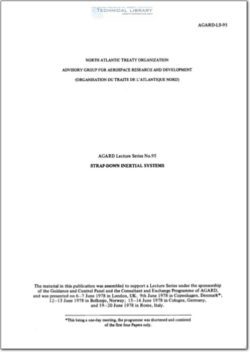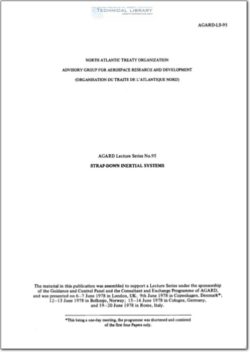AGARD-LS-095

- Version
- 159 Downloads
- 9.87 MB File Size
- 1 File Count
- March 9, 2016 Create Date
- March 9, 2016 Last Updated
Strap-Down Internal Systems

To operate the gyro in a strapdown mode, the pickoff angle is electrically servoed to null by the
torque generator which is driven by the signal-gcnerator/pickoff output (through suitable compensation
and amplifier electronics). The time integral of the difference between the input and torque—generator
processional rates is thereby maintained at zero, and the integral of the torque-generator rate becomes
proportional to the integral of the input rate. Thus, the integral of the torque-generator electrical cur-
rent provides a measure of the integral of input rate for a rate-gyro strapdown inertial navigation
system.
The suspension assembly for the floated gyro is typically of the pivot—and—jewel type, Somc units
a dditionally employ a magnetic suspension around the pivots to eliminate friction under benign flight
conditions, and to compensate for off—nominal flotation.
The signal-generator/pickoff is either of the moving—Coil or variable—reluctance type. For the
moving—coil pickoff, a small receiver coil is mounted to the float and an a-c excitation cml is attached
to the case. ilovcmcnt of the float relative to the case modifies the flux linkage sensed by the receiver
coil; hence, a d-c voltage-output is generated from the receiver coil proportional to float-case angular
d laplacement. For the variable—reluctance piclcoi‘f, the excitation and receiver coils are mounted to the
c ase, and a soft—iron assembly is attached to the float in the flux return path between the excitation and
receiver coils. Movement of the float relative to the case varies the orientation of the soft iron in the
excitation field, thereby modifying the return flux to the receiver coil. The receiver-coil voltage there-
by becomes proportional to float-case angular displacement. The tradeoff between the two pickoff ap-
proaches is the addition of two flex leads (and associated error-torque uncertainties on the float) for the
moving-coil pickoff versus increased error—torque magnetic sensitivity (to internally generated fields)
for the variable-reluctance pickoff.
| File | Action |
|---|---|
| AGARD-LS-095 Strap-Down Internal Systems.pdf | Download |
Comment On This Post